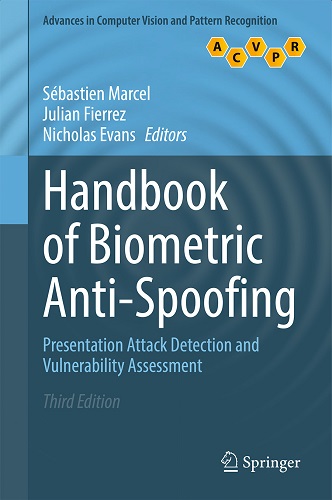
Handbook of Biometric Anti-Spoofing: Presentation Attack Detection and Vulnerability Assessment (Third Edition)
English | eBook | Size: 17.75 MB
It is a pleasure and an honour both to write the Foreword for a leading and prestigious book. This is the Third Edition of the Handbook of Biometrics Anti-Spoofing and I was co-editor for the first two Editions, and now I have been promoted. (More realistically, I have not worked in Anti-Spoofing for some time now.) So I admit bias, and I am taking the opportunity to look at the book from the outside. Essentially, I shall aim to substantiate my claim that the Handbook is indeed leading and prestigious, and I find it not hard to do.
The first evidence I can offer is that the Handbook was the first text to concentrate on anti-spoofing. There appear to be no other books yet which concentrate on this important topic, though it is among the content of some and naturally within those describing the security domain. I have been privileged to be involved in biometrics from its earliest days, in my case in the 1980s before the word biometrics was coined. Even then we knew that if we were working or were ever to work properly, then we needed to countenance the possibility that someone would try and break the system. In modern terminology, we did not consider the possibility that there might be spoofing or presentation attacks. In the First Edition, I, Sébastien, and Stan Li (the Editors then) argued at length over whether the book should be titled “Spoofing” or “Anti-spoofing”-and that is the nature of pioneering work: one does not even know how best to describe it. So the Handbook’s uniqueness and initiative strongly underpin a claim that the text is leading and prestigious.
Secondly, the evidence concerns the people involved: those who have edited this Handbook, those who have authored its Chapters, and those who have reviewed them. Sébastien Marcel is well known for his work in multi-modality anti-spoofing, Nicholas Evans is well known for his works on speech and other biometrics, and Julian Fierrez is well known for his prize-winning works on face and signature. All have contributed to the infrastructure this fascinating subject requires and are due many accolades for their other contributions. This is a great team of Editors. Then we find a cohort of authors who are leading lights in this topic area, and like the Editors, they too have contributed to the infrastructure and the building of this topical material. That the contributors derive from many leading institutions around the world further underpins the suggestion that the pedigree of those involved emphasizes the claim that the text is leading and prestigious.
The third evidence is that the book’s coverage is highly appropriate to lead the way in studies of anti-spoofing. The coverage includes major modalities, like Finger, Face, Iris, and Voice (noting that voice/speaker is often-unfortunately-considered within the signal/speech domain rather than within biometrics). There are naturally other biometrics. In previous editions, these have included signature, gait, and vein and two of these maintain in the new Edition. There are also methodological contributions and there is updated material on standards and legal issues. The latter two are of enormous importance as identity verification and recognition continue to pervade society and enable convenient, practicable, and secure access. So the comprehensiveness and the insight afforded by the Handbook’s structure reinforce the claim to leadership and prestige.
There are many other metrics that further contribute to this evidence. The Handbook has been highly cited in its previous two Editions, and naturally, the Chapters within it have their own citations too. My own students have enjoyed the book, and many others do. The book is published within Springer’s excellent series on biomet-rics. Then there are sales and library penetration, neither of which I can assess. That a book reaches its third Edition assures one of the market penetration since publishers will not consider furthering texts that have not proved substantially their value. Even in my biased view, I find it easy to find evidence that this book is the leading and prestigious book and a pioneering text in biometric anti-spoofing. By its content, presentation, ethos, and style, the Third Edition of the Handbook of Biometrics Anti-Spoofing makes an excellent addition to this compelling series.
DOWNLOAD:
Leave a Reply